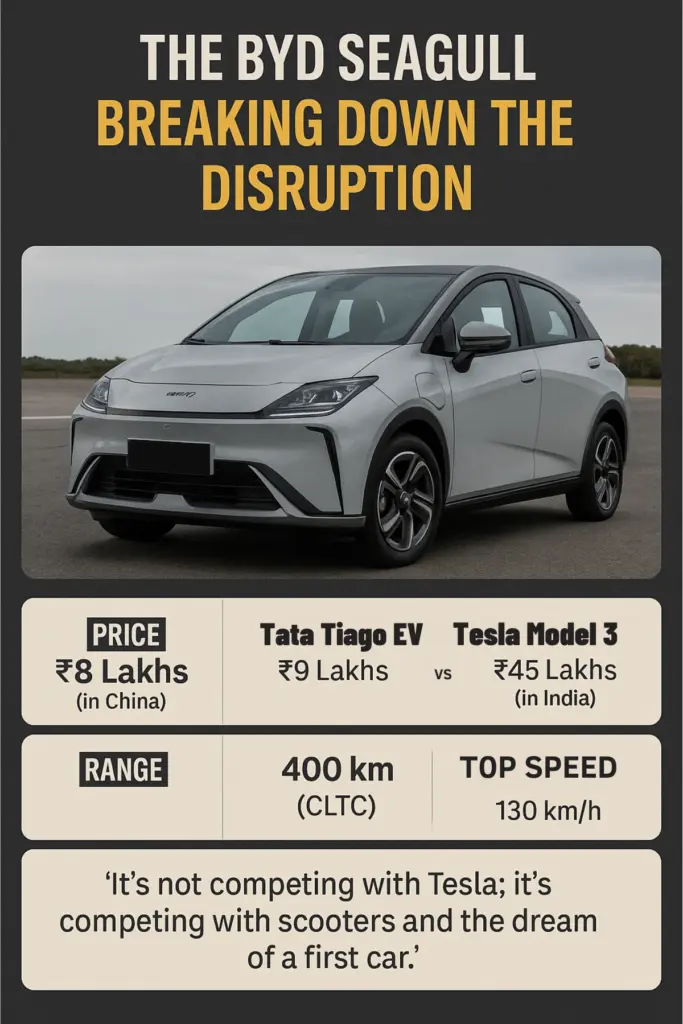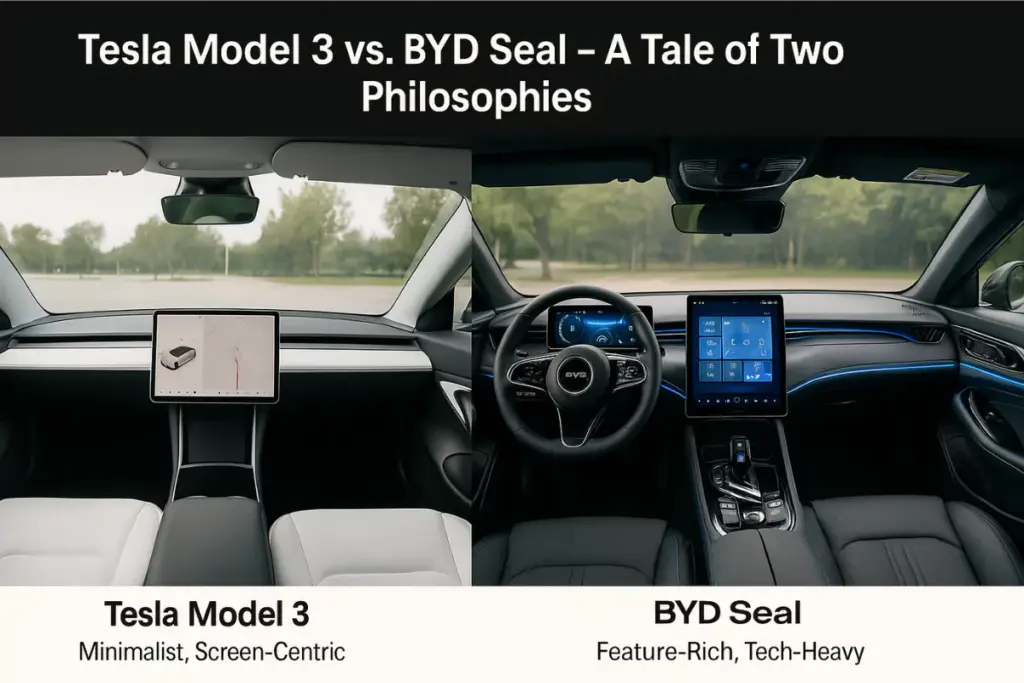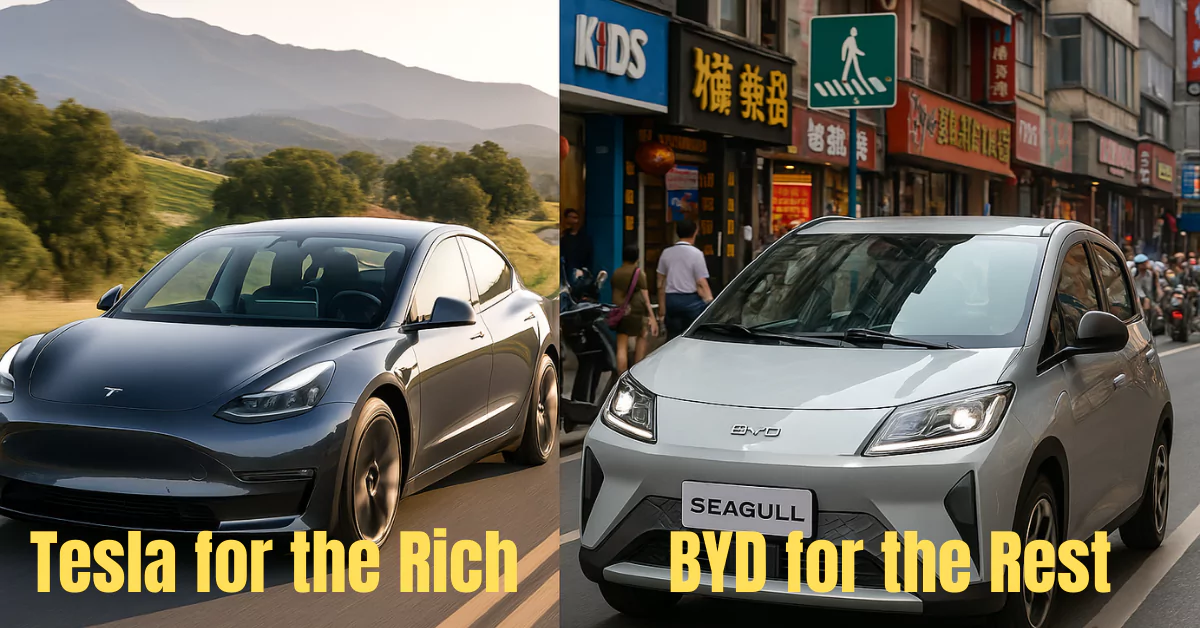| BYD just dethroned Tesla as the world’s top EV seller. Discover the story of this Chinese giant, its game-changing $10,000 car, and why its strategy of affordable innovation is a blueprint for India’s electric future. |
The EV Crown Has Slipped
In the final quarter of 2023, a seismic shift occurred in the automotive world. BYD, a company many outside China were unfamiliar with, sold more pure electric vehicles (BEVs) than Tesla, the iconic pioneer led by Elon Musk.
This wasn’t a fluke. It was the inevitable result of two radically different strategies. If Tesla is the sleek, premium iPhone of the EV world, BYD has become its practical, affordable, and ubiquitous Android. This is the story of how the electric car for the masses arrived, not from Silicon Valley, but from Shenzhen. And its lessons are crucial for the future of mobility in India. The Rise of BYD, from batteries to billion dollar cars, is not an overnight phenomena, but a strategic inovation and marketing approach.
The $10,000 Wonder: A Game Changer for Millions
Imagine an electric car that costs less than a premium petrol-powered hatchback in India. A car so affordable it makes EV ownership a reality for millions in megacities from Mumbai to Chennai. This isn’t a futuristic concept; it’s the BYD Seagull (Honor Edition in China), and it’s the clearest symbol of why BYD is winning the volume game.
Starting at just ¥69,800 (approx. ₹8 lakhs) in China, the Seagull is a no-frills, four-seater hatchback built for urban chaos. It offers a practical range of up to 250 miles (400 km) – perfect for daily commutes.

While the Seagull isn’t officially here yet, its existence sets a benchmark. It competes not with premium EVs, but with congested buses, two-wheelers, and the dream of affordable, safe, and clean personal mobility for the Indian middle class. It proves that mass EV adoption hinges on unprecedented cost control, something BYD achieves by vertically integrating everything from lithium mines to the chips inside its cars.
Read Also: Why BYD is Outselling Tesla in Europe: Key Reasons Behind the Chinese EV Giant’s Rapid Rise
Tech and Comfort: Where the “Affordable” Car Feels Premium
BYD’s strategy isn’t just about being cheap. It’s about offering stunning value. Compare the Tesla Model 3 to its direct BYD rival, the Seal.
- Tesla Model 3: Minimalist, software-first, driver-centric. A single screen controls everything. The experience is fantastic but can feel sparse.
- BYD Seal: Often priced significantly lower. You get a rotating central screen, a digital instrument cluster, soft-touch materials, and features like massaging seats and ventilated rear seats, things unheard of in a Tesla at this price.

This is a cultural masterstroke. For consumers in India and Asia, a car is often the family’s largest purchase. Features and tactile luxury that scream “value for money” can be more immediately appealing than minimalist tech. BYD understands this psyche perfectly.
Read Also: BYD Seal U: Full Specs, Features & Why It’s a Game-Changing SUV
Tesla For the Rich
Tesla simply cannot, and will not, make this car. Elon Musk’s vision has always been a top-down approach: start with a high-end luxury sports car (the Roadster) to fund a premium sedan (Model S), and eventually create a “mass-market” car.
But the Model 3 and Y, while Tesla’s most affordable offerings, still start at over $40,000 in the US, placing them firmly in the premium category for most of the world.
BYD, in contrast, started from the bottom and is now moving up.
The Seagull proves that BYD’s ultimate advantage isn’t just technology, it’s unprecedented cost control through vertical integration, owning everything from the lithium mines to the chips inside its cars.
From Copycat to Innovator: The Brand Perception Shift
A decade ago, BYD (Build Your Dreams) was known for producing dubious copies of Toyota Corollas. Today, it’s a tech leader. How?
Audacious Design: BYD hired world-class designers from Audi, Mercedes, and Lamborghini. Cars like the Han EV and the Seal are now sleek, modern, and distinctive.
Core Innovation – The Blade Battery: This was a masterstroke. Their Lithium Iron Phosphate (LFP) battery is cheaper, longer-lasting, and crucially, far safer. It famously passed a nail penetration test without catching fire, directly addressing a major consumer anxiety, especially in markets like India where safety is a growing concern.
This innovation allowed BYD to rebrand itself not as a cheap copy, but as a safe, reliable, and smart choice.
The Charging Question: A Lesson for India’s Infrastructure
A common retort is Tesla’s unparalleled Supercharger network. This is a huge advantage in the West, but the story is different in China and holds lessons for India.
- China’s Approach: The government and private players built a ubiquitous public charging infrastructure with over 2 million points. Finding a charger in Shanghai is as easy as finding a petrol pump.
- BYD’s Tech: Their focus on LFP batteries means many customers are happy with slower, overnight charging at home, reducing daily dependence on fast chargers.
India’s EV strategy is mirroring this. The government’s FAME scheme and initiatives by companies like Tata Power to install thousands of chargers are creating a shared infrastructure, not a single proprietary network. This neutralizes the “charging advantage” for any one brand and benefits the entire ecosystem.
The Bottom Line: The EV for the Rest of Us
BYD’s ascent is more than a sales victory; it’s a validation of a different vision for the electric future.
- Tesla proved electric cars could be desirable.
- BYD is proving they can be attainable.
Tesla will likely remain the aspirational, high-performance brand. But BYD, with its affordable Seagulls and value-packed sedans, has become the champion for the “Rest”, the millions for whom a car is not a luxury statement but a necessary tool for life.
For India, a country on the cusp of an electric revolution, the BYD story is a powerful case study. It proves that the future of EVs isn’t just about cutting-edge technology for the few, but about smart, safe, and staggeringly affordable innovation for the many.
The volume game is over. For now, BYD has won. The question is, which path will Indian automakers learn from the most?
What do you think? Is an affordable, mass-market EV like the BYD Seagull the key to India’s electric dreams? Let us know in the comments below!
